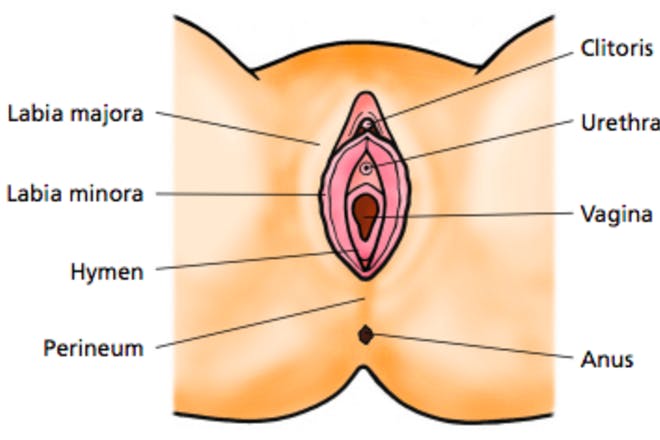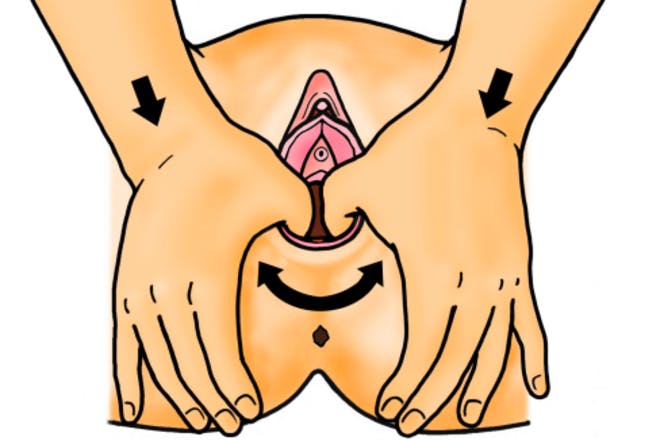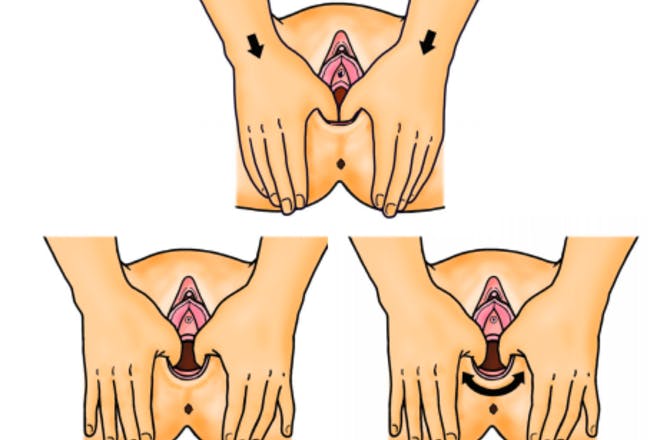We all know that a pregnancy massage is a great way to ease those aches and pains. But there's another massage that all mums-to-be need to know about – and do – in the weeks leading up to labour and birth. Here's why you should be practising your perineal massage.
This page contains affiliate links, which means we may earn a small amount of money if a reader clicks through and makes a purchase. All our articles and reviews are written independently by the Netmums editorial team.
What is a perineal massage?
Perineal massage is an antenatal technique used to stretch and prepare an area 'down there' called the perineum. Much like pelvic floor exercises, perineal massage is an important part of the process in preparing your body for birth.
By making your perineum more supple and stretchy, the massage can help prepare for labour and birth, making it easier during delivery for the baby to come out. It can also reduce the risk of:
- tearing
- requiring an episiotomy
- needing stitches after labour
NHS advice is to start doing your perineal massage once you're about 34 weeks pregnant and well into your third trimester.
FREE NEWBORN NAPPIES
Where's my perineum?
You may not have heard of the perineum, but don't worry – it's easy to find! It's the area of skin and muscles between your vagina and anus (the opening to your back passage).
During labour and birth, this area gently and naturally stretches to enable the baby's head to fit through your vagina and be born. Massaging this area (see how to do it below) simply gives it a bit of a head start and helps prepare it for this stretching process.
See the diagram below to help locate it ...
How to do a perineal massage
It's quite an intimate manoeuvre, so you may choose to do it in bed or the bathroom – basically, somewhere you have a bit of privacy.
Doing perineal massage during or after a warm bath or shower can be helpful, as the blood vessels in the area will be dilated, which can make it more comfortable. And make sure your fingernails are trimmed and clean first!
You can either do it yourself, or ask your partner to do it for you.
When you're ready, follow these steps from midwife Kay Hardie, of Kent Midwifery Practice:
- Stage one: squat or sit on the toilet or bed and insert your thumb into your vagina, and then, with control, gently press backwards and down towards your bum. You'll feel pressure and a stretching sensation against the triangle of skin, which is normal.
- Use fingers rather than the thumb, if you prefer. Try two fingers, inserted about 5cm into the vagina, using the same 'back and down' movement.
- Although you don't need any special lubricant, some find it more comfortable to use a drop of olive or vegetable oil to help your thumb glide in (up to the knuckle).
- Once you're used to the sensation, you can do this in bed, propped up on pillows, if it's more comfortable.
- Using small movements, move your thumb or fingers from side-to-side in a 'U'-shape so you're gently stretching the skin, increasing the pressure on the area as you get used to the feeling.
- Do this for two or three minutes.
- It might feel like burning or tingling – again, this is normal, and is the same sort of pressure you'll feel as your baby's head crowns.
- Now massage the lower part of the vagina back and forth, taking care while you gently pull and stretch the tissue (as your baby's head will do as it passes through the birth canal and out of your vagina.)
- Repeat for a couple of minutes.
The first couple of times you attempt perineal massage will be trial and error, just keep practicing until it feels right for you.
Perineal massage shouldn't be painful, though it can be pretty uncomfortable. If you are finding it hurts, especially after you've been doing it for a few weeks, discuss with your GP or midwife who can help to check your technique.
What are the main benefits of perineal massage?
According to the NHS , up to 9 out of 10 women will experience a degree of tearing or grazing as part of vaginal birth, while 1 in 7 will need an episiotomy . Around two-thirds of tears will require stitches.
Less commonly, damage to the perineum can lead to issues with the pelvic floor, like urinary or fecal incontinence, uterine prolapse, or sexual discomfort. Preventing this happening through perineal massage, is therefore really beneficial.
Some of the benefits of perineal massage include:
-
Preparing the tissues:
Massage increases blood flow and should help the tissues and skin stretch with more ease, meaning less pain during childbirth.
-
Lowers risk of tearing:
According to Healthline, around 1 in 15 women who regularly do perineal massage don’t need an episiotomy or otherwise experience a tear that requires stitches.
-
Reduces the need for stitches after birth:
Evidence from one study shows it may reduce the need for stitches by as much as
10%
. This means that massaging the perineum may make tearing less severe.
-
Helps those with scar tissue:
Women who have had a previous injury or otherwise have a rigid perineum (such as dancers and horse riders) may find that massage is especially helpful.
-
Prepares you better for birth:
Paying attention to the area that stretches the most during delivery allows you to focus on relaxing. This may help you to cope with any pain both physically and mentally.
How long should it take?
Midwives advise that perineal massage doesn't have to be time-consuming - 'two or three minutes every day is plenty', says Kay.
'Any more than that and it becomes a bit of a chore - pregnant women have enough to fit into their day as it is.
'It's better to do short, regular massages than a longer one once a week or not at all.'
Does perineal massage really work?
In a word, yes!
A Cochrane (expert health) report that reviewed four studies of nearly 2,500 women showed that perineal massage reduced the likelihood of perineal trauma and tearing, and recommended that women should be informed about the benefits.
Research found that regular perineal massage during the last few weeks of pregnancy reduced the likelihood of the need for an episiotomy and stitches.
Studies have also found that perineal massage is particularly beneficial in women having their first vaginal birth. If you've never given birth vaginally before, massaging your perineum towards the end of your pregnancy can reduce your risk of episiotomy . It may also reduce your risk of a tear.
For women who have had more than one vaginal birth, perineal massage can help reduce postpartum perineal pain in the months following childbirth.
Which oil should I use?
NHS advice recommends using olive oil, sunflower oil or sweet almond oil (don't use this one if you have a nut allergy) as lubrication.
If you're sensitive to any of these you can use a water-soluble lubricant jelly, or a personal lubricant – so long as it's unscented.
Avoid using baby oil, mineral oil, petroleum jelly or other petroleum based products.
There are special perineal massage oils. We like this all-natural oil by Weleda. See more details here at Amazon.
We also love this oil by My Expert Midwife called Prep Your Bits. See more details at Boots.
I had stitches after having my first baby. Is it safe to do?
'Yes it is,' says Kay.
'Women are naturally very worried about tearing during subsequent births but in fact studies show it's very unlikely to happen again - the area is not weakened or more delicate, so it's fine to massage as long as it feels comfortable.'
Is there any reason NOT to do perineal massage?
If you're having a planned caesarean, there's less concern about the perineum because it only comes under pressure if you're giving birth vaginally.
'Also, if you try it and don't like it, don't feel you must carry on - it's a very personal choice,' says Kay.
The NHS also advises not to perform perineal massage if:
- you think your waters may have broken
- you have thrush
- you have herpes or any other vaginal infection
Can my partner do it for me?
By all means get your other half in on the act!
'Just make sure they're gentle and that they don't apply pressure to the urinary opening (urethra), to avoid a urinary tract infection , because you're more prone to these during pregnancy,' says Kay.
Of course, massaging your perineum isn't the only way to prepare your body for giving birth.
It's also important to keep up with your pelvic floor exercises , and stay as healthy as possible throughout your pregnancy by eating a healthy diet, and keeping active.
Have you tried a perineal massage to prepare for labour? Let us know what you think over on our forum!










